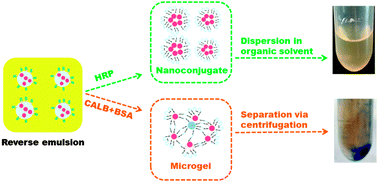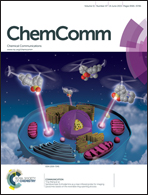A general method for synthesizing enzyme–polymer conjugates in reverse emulsions using Pluronic as a reactive surfactant†
Abstract
Using aldehyde-functionalized Pluronic as the reactive surfactant, enzyme–Pluronic conjugates with sizes ranging from nanometers to micrometers were synthesized in reverse emulsions. Compared with the direct conjugation in aqueous solution, this method gave an increased conjugation efficiency and well-controlled size of the conjugates. The versatility of this method was validated using horseradish peroxidase (HRP), Candida rugosa lipase (CRL) and Candida antarctica lipase B (CALB). The resulting enzyme–Pluronic conjugates showed greatly enhanced apparent activity compared to free enzymes in organic media.


 Please wait while we load your content...
Please wait while we load your content...